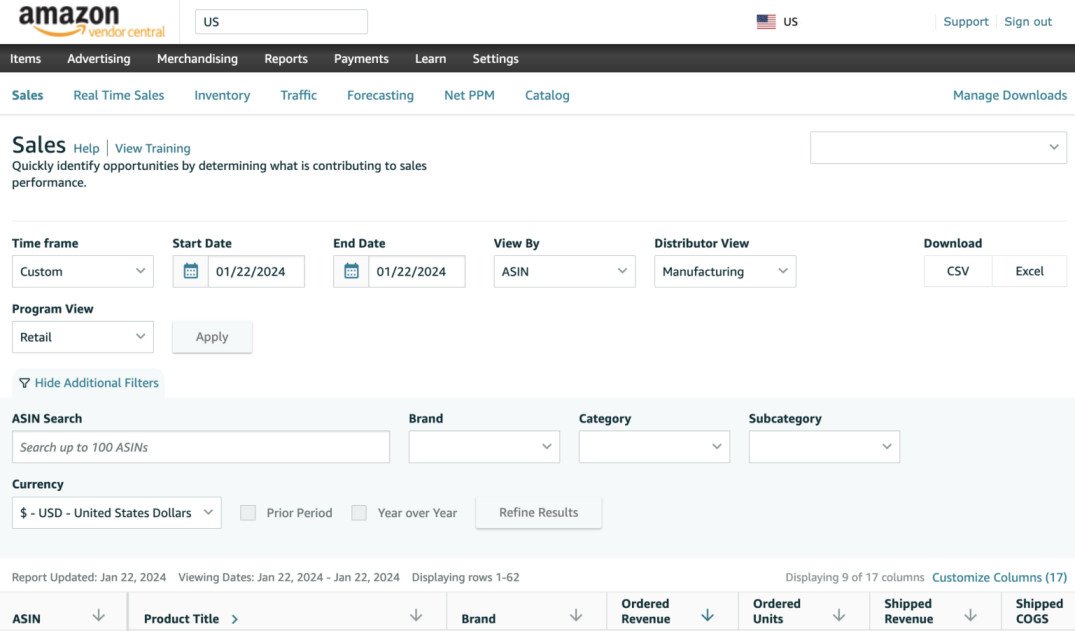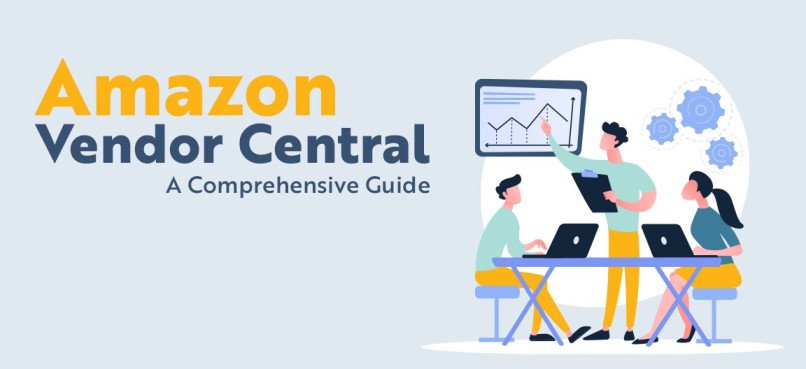As Amazon remains the most popular and influential playground in e-commerce across the world, brands and manufacturers keep on thinking of new opportunities to empower their presence on the platform. Amazon Vendor Central is one of the effective channels. Misunderstood and often compared to Seller Central, Vendor Central is a specific and rather wholesale-like arrangement with Amazon that can mean different benefits to deserving business.
This in-depth 2025 guide covers all you should know about Amazon Vendor central: how it functions, its advantages, drawbacks, how it contrasts with seller central, and whether it is the correct option for you.
What Is Amazon Vendor Central?
Amazon Vendor Central is a service that works with manufacturers and distributors that directly sell to Amazon. Instead of listing your products and selling them to consumers (as you would do through Seller Central), through Vendor Central the products are sold to Amazon in bulk, and Amazon becomes the retailer selling your products to its customers.
Vendor Central vs. Seller Central
Key Characteristics
Invite only: You have to be invited by Amazon.
Wholesale Relationship: You will sell to Amazon at wholesale prices.
Amazon Manages Retail: Amazon covers pricing, fulfillment, and customer service.
Making Vendor Central a perfect fit to existing brands seeking to expand their operations into the retail capacities of Amazon.
How Amazon Vendor Central Works
Step-by-Step Overview
- Inviting and Onboarding: Amazon vendor recruitment team invites you.
- Product Setup: You input specifications, images, and descriptions of the product on the platform.
- Purchase Orders (POs): POs are sent out by Amazon when it intends to buy inventory.
- Fulfillment: You send the ordered quantities to Amazon warehouses.
- Retail Sales: Amazon catalogs your items and takes care of the whole of the retail sale process.

Vendor Central Dashboard
The tools available in the Vendor Central dashboard are:
- Purchase Order Management
- Building A+ content (product enhanced listing)
- Amazon marketing services (AMS) advertising
- Viewing reports and analytics
Benefits of Using Vendor Central
1. Retail Credibility
Brands that are sold in Amazon directly tend to have a greater weight in consumer mindset. The shipping label, Ships from and sold by Amazon.com, can highly increase trust and conversion.
2. Improved Branding and A+ Content
Sellers are allowed to generate A+ content, enabling more detailed product descriptions, comparison tables, presentations, and early brand narratives.
3. Amazon Marketing Services (AMS)
Users of Vendor Central get access to powerful marketing opportunities such as Sponsored Products, Sponsored Brands, and Product Display Ads.
4. Broader Microsale and Inventory Exposure
Amazon is likely to rank Vendor-supplied products higher on the search results and Buy Box assignment. This can lead to improved visibility and a larger volume of sales.
5. Simplified Logistics
Sellers deliver in large quantities to Amazon fulfillment centers and Amazon handles individual customer deliveries, refunds and customer support.
Disadvantages and Challenges of Vendor Central
1. Insufficient Pricing Control
As soon as Amazon purchases your product, it has a control over the selling price. This may cause erosion of prices or undercutting other channels.
2. Chargebacks and Penalties of Compliance
Amazon has stringent packaging, labeling and shipping standards. Failure to comply is likely to involve fines.
3. Delayed Payments
The cash flow will also be affected by typical payment terms which are set between 30-90 days once the shipment has been received by Amazon.
4. Limited Communication
The vendor support team at Amazon is often slow in responding to issues and provides limited support to vendors.
Vendor Central vs. Seller Central
| Feature | Vendor Central | Seller Central |
|---|---|---|
| Account Type | Invite-only (wholesale) | Open to all (direct-to-consumer) |
| Product Ownership | Amazon owns the inventory | Seller owns the inventory |
| Pricing Control | Amazon sets the retail price | Seller sets the retail price |
| Fulfillment | Vendor ships to Amazon warehouses | Seller can choose FBM or FBA |
| Marketing Tools | Access to AMS | Sponsored Products & Brands |
| Customer Service | Handled by Amazon | Handled by seller or Amazon (FBA) |
| Profit Margins | Typically lower | Potentially higher |
Invited to Amazon Vendor Central
1. Establish a Positive Brand Image
Amazon frequently goes after:
- High performing products on seller central
- Rare or desirable goods
- A robust social media or DTC following
2. Go to Trade Shows, Amazon Events
Attending industry events has the potential to place you on the radar of Amazon.
3. Agency or Partner with a Distributor
There are agencies specialized to enable brands to get invited to Vendor Central.
4. Contact Vendor Managers
You may work proactively by reaching out to category managers at Amazon in cases when your brand has been selling well.

Best Practices for Vendor Central Success
1. Maintain Compliance
- Use Amazon packaging, labeling, and shipping guidelines thoroughly.
- Refer to Amazon routing rules and vendor prep guidelines.
2. Improve A+ Content
- Use a high-resolution image, comparative tables, and narratives to explain the fantastic features of the products.
- Make sure that the content meets Amazon best practices of SEO.
3. Use Amazon Advertising
- Advertise with Sponsored Brands to increase awareness.
- Test various ads and observe ROI.
4. Use Analytics to monitor Performance
- Monitor indicators such as purchase order fill rate, operational chargebacks, and vendor lead time.
- Learn more with Amazon Retail Analytics (ARA) Premium.
Common Issues and How to Resolve Them
1. Shortages and Chargebacks
- Consider using prep services when you do not have compliance competencies within your company.
- Validate all PO with guidelines.
2. Inventory Management Issues
- Predict the demand and seasons.
- Do not oversupply stock that you may pass to Amazon.
3. Retail Disruption and Price Matching
- Monitor MAP policies in channels.
- Consider Seller Central (hybrid model) with Vendor Central
Is Vendor Central Right for Your Business?
Vendor Central – if:
- You are a manufacturer/built-in brand
- You are able to deal with wholesale lots
- You are comfortable with Amazon handling the end-consumer relationship
Do not leave Seller Central If:
- You desire to exercise complete pricing and brand messaging authority
- You are lean or new to the game
- You desire quicker payments and flexibility
Use a Hybrid Approach When:
- You envy to have both the worlds
- You are running multiple SKUs and you need to test performance among channels
FAQs
Is Vendor Central available to all?
No. Amazon Vendor Central is by invitation only. But successful brands with sales history on Seller Central can be invited.
How do payments occur in Vendor central?
The general terms of Amazon are to pay the vendors 30 to 90 days after the shipment is received.
Is it possible to move Vendor Central to Seller Central?
Yes, but make the transition well planned, without losing any sales or suppressing the products.
Is Vendor Central an improvement over Seller Central?
It is based on your objectives. Vendor Central provides a scale and retail visibility, whereas Seller Central enables a greater level of control and flexibility.
Does Vendor Central have account management services?
Yes. There are several agencies that focus on Vendor Central on-board, PO management, and advertising services.
Conclusion
Amazon Vendor Central provides a powerful store where large-established brands and manufacturers can leverage the retailing engine of Amazon. Although it offers great benefits such as credibility, bulk selling, and access to advertising, it also has drawbacks like less control and complicated compliance.
The secret to success consists of learning the platform, sticking to high operational standards, and maximising the benefits of marketing and analytics tools. Are you contemplating switching out of Seller Central, considering a hybrid approach, or find yourself invited to Vendor Central? It can be a worthwhile growth opportunity when approached strategically.
Evaluate positives and negatives, determine your readiness of operations, and consult Amazon consultants or agencies before pressing the button. Using proper strategy, the Vendor Central will allow you to take your brand to the new level and achieve tremendous growth on the largest online marketplace in the world.

